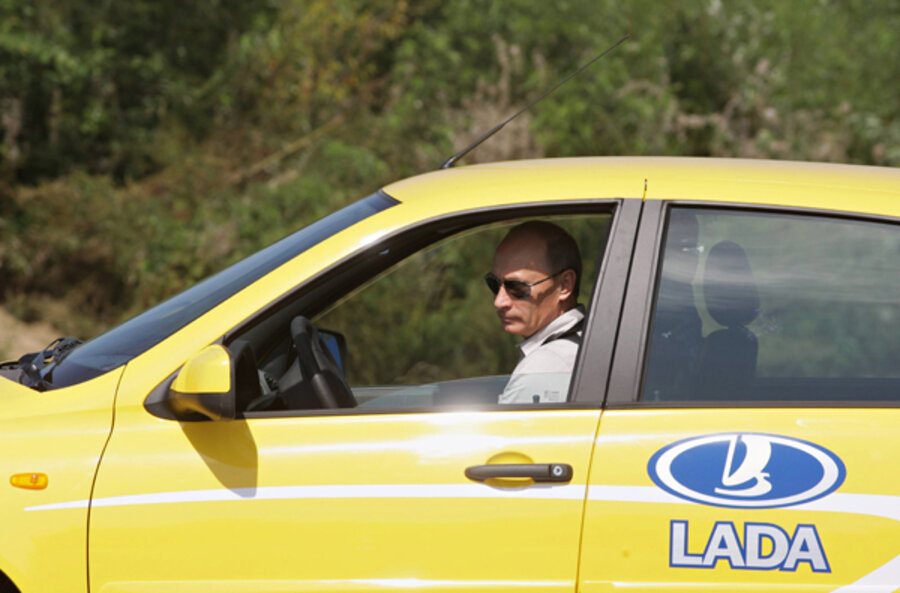Vladimir Putin to get a new, Russian-made ride
Loading...
| Moscow
President Vladimir Putin has decided to ditch the foreign-made armored limousines that have served Kremlin leaders since the collapse of the USSR, and get himself a patriotic Russian ride.
Mr. Putin, who recently vowed to drive less and work from home more often, believes that Russian officials should ride in domestically built automobiles, he told a TV news program this week. And a prototype of the new "Limo No. 1," the new ZiL-4112P, is now ready for road testing, he added.
The sleek new car that Putin and other top Russian leaders will soon be riding around in, on Kremlin orders, is an updated version of the old ZiL limousines that carried Soviet Politbureau members to and from their dachas back in the days of the USSR.
But Mikhail Sattarov, director of special production at ZiL, says the new limo, which has been six years in the making, will be much more than one of those clunky old Soviet armored soapboxes that can nowadays be seen only in newsreels.
"This is a new car, the first prototype of a new series. We hope that if Putin decides to use it, it will have a favorable impact on the situation in the Russian automobile industry in general," Mr. Sattarov says.
"It's a Russian car, with a Russian-made engine. It has some of the features of the previous ZiL limousines, but it's got a new look. When you see it, it's not an old ZiL, and it's not a Mercedes. We think it's much better looking than the Cadillac [US President Barack] Obama drives around in – which is like a scary submarine, scary to look at," he adds.
The new-look, hand-tooled ZiL weighs 3.5 tons (without armor), has six doors, and a 7.7 liter engine that should require just 7 gallons of gas to go about 60 miles, with a top speed of 125 mph. That's apparently a big improvement over former Soviet leader Leonid Brezhnev's ZiL, which burned 17 gallons to go the same distance.
The interior will feature plush calf-leather seats, a full workstation, and a TV screen connected with an external video camera that will enable the driver and passengers to see what's going on around even if they have to lower armored shutters over the windows. Mr. Sattarov says it will also have unique security features, based on secret Russian technologies, to guarantee passengers' safety in almost any conditions.
Experts say that the idea of Putin and other top officials switching to a Russian-made car is about more than prestige.
"It's a symbol of support for the Russian auto industry," says Mikhail Ganelin, a senior analyst with the state-owned Sberbank, Russia's largest bank.
"We do still have an extensive auto industry, even if we have no current luxury brands. And it's worth mentioning that Russia is the second largest market for cars in Europe, after Germany. Decisions like this have an impact," Mr. Ganelin adds.
Former Russian President Boris Yeltsin tried to force officials to switch from popular Mercedes and BMW limousines to Russian-made models back in the 1990s, without the slightest success.
No one knows how much has been invested in the new ZiL, but it could be substantial. Experts say that it can cost up to $1 billion to develop a completely new model, though Putin's new ride is most likely a version of the old Soviet car with a few upgrades.
"The USSR could do these things, by throwing endless money at leaders' cars and such," says Igor Morzharetto, an expert with Za Rulyom (Driver) magazine.
"But the schools for specialists have been lost, and we do not have skilled workers for the production lines anymore.... The engine for a car like this should be perfect, with no faults. We don't have such engines in Russia, or the chance to produce them. Even to assemble such a car costs big effort," he adds.
"And I don't really understand why we need it. It won't change anything at the basic level of our auto industry. You can order all the officials to part with their foreign cars and drive domestic Russian ones, but has anyone really counted the costs? Of course, if Putin orders it, it will be done."








